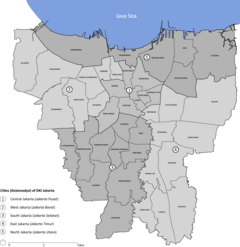Sawah Besar railway station

B04 Sawah Besar Station Stasiun Sawah Besar | |||||||||||||||
|---|---|---|---|---|---|---|---|---|---|---|---|---|---|---|---|
 Sawah Besar Station | |||||||||||||||
| General information | |||||||||||||||
| Location | Jl. Kyai Haji Samanhudi, Sawah Besar, Central Jakarta Jakarta Indonesia | ||||||||||||||
| Coordinates | 6°09′38″S 106°49′40″E / 6.160667°S 106.827639°E | ||||||||||||||
| Elevation | +15 m (49 ft) | ||||||||||||||
| Owned by | Kereta Api Indonesia | ||||||||||||||
| Operated by | KAI Commuter | ||||||||||||||
| Line(s) | |||||||||||||||
| Platforms | 2 (side platforms) | ||||||||||||||
| Tracks | 2 | ||||||||||||||
| Construction | |||||||||||||||
| Structure type | Elevated | ||||||||||||||
| Accessible | Available | ||||||||||||||
| Other information | |||||||||||||||
| Station code | SW[1] | ||||||||||||||
| History | |||||||||||||||
| Opened | 15 September 1871 (NIS)[2] | ||||||||||||||
| Opening | 05 June 1992 [3] | ||||||||||||||
| Electrified | 06 April 1925 [3] | ||||||||||||||
| Previous names | Sawah Besaar Station | ||||||||||||||
| Services | |||||||||||||||
| |||||||||||||||
| |||||||||||||||
Sawah Besar Station (formerly Sawah Besaar Station) is a railway station, located on Jl. Kyai Haji Samanhudi. Altitude this station is 15 meters amsl, this station is one of seven elevated stations on Jakarta railway's Jakarta Kota–Manggarai segment, and is named after the Jakarta subdistrict with the same name. Pasar Baru market is within walking distance from this station.
History
[edit]
Sawah Besar Station is one of the oldest railway stations in Batavia, located on the Batavia–Weltevreden section of the Batavia–Buitenzorg railway line which was inaugurated by the Nederlandsch-Indische Spoorweg Maatschappij (NIS) on 15 September 1871. Initially, this station was a simple train stop. which was named Sawah Besaar and changed its name to Sawah Besar in the late 1890s.[4][5]
On 5 June 1992,[3] President Suharto along with Mrs. Tien and staff in the government inaugurated the elevated track by riding the train from Gambir to Jakarta Kota station. The building of Sawah Besar Station is modern with touches of pink and white panels, which to this day are still preserved and have not been repainted. It is known, the project which was started in February 1988[3] spent Rp 432,5 billion[citation needed] and when it was inaugurated it was not completely finished until finally it could be fully operational a year later.[6][7][8]
Building and layout
[edit]The Sawah Besar Station building is modern with a touch of lilac colored panels which are still maintained to this day and have never been painted, only the pillars of the platform have now been painted pale pink. It is known that the project, which began in February 1988, spent Rp. 432.5 billion and was not fully completed when it was inaugurated, so that it was fully operational a year later.[1][8]
This station has only two railway lines.
| Platform floor | Side platform, the doors are opened on the right side | |
| Line 1 | ← (Mangga Besar) | |
| Line 2 | ||
| Side platform, the doors are opened on the right side | ||
Services
[edit]The following is a list of train services at the Sawah Besar Station.
Passenger services
[edit]- KAI Commuter
 Bogor Line, to Jakarta Kota and Bogor
Bogor Line, to Jakarta Kota and Bogor Bogor Line (Nambo branch), to Jakarta Kota and Nambo
Bogor Line (Nambo branch), to Jakarta Kota and Nambo
Supporting transportation
[edit]| Type | Route | Destinatiom |
|---|---|---|
| Mikrotrans Jak Lingko | JAK-10 | Jakarta Kota–Tanah Abang |
| Mikrolet[9] | M12 | Senen–Jakarta Kota |
References
[edit]- ^ a b "Buku Informasi Direktorat Jenderal Perkeretaapian 2014" (PDF). Archived from the original (PDF) on 1 January 2020. Retrieved 7 March 2023.
- ^ "Heritage - Kereta Api Indonesia" (in Indonesian). Archived from the original on 10 September 2020. Retrieved 30 April 2020.
- ^ a b c d "Awal Mula Jalur Layang Kereta di Indonesia - Historia" (in Indonesian). Hendaru Tri Hanggoro. 19 April 2019.
- ^ Lohanda, Mona. (2007). Sejarah para pembesar mengatur Batavia (Cet. 1 ed.). Depok: Masup Jakarta. ISBN 978-979-25-7295-7. OCLC 225750927.
- ^ Burgerlijke Openbare Werken (1896). Statistiek van het vervoer op de spoorwegen en tramwegen met machinale beweegkracht in Nederlandsch-Indië. Batavia: Landsdrukkerij.
- ^ Rudi, Alsadad (30 August 2013). "Setelah 22 Tahun, Proyek Jalur Layang Kereta Jakarta Dilanjutkan". KOMPAS.com (in Indonesian). Retrieved 7 March 2023.
- ^ Kayang, U. (2019). Keping-keping Kota. Bantul: Basabasi. p. 92.
- ^ a b "Kereta Layang: Melayang di Atas Jalur Kumuh". Majalah Tempo. 22: 32. 1992.
- ^ "Daftar Trayek Angkutan Umum DKI Jakarta". Pemerintah Provinsi DKI Jakarta. Retrieved 7 March 2023.
External links
[edit] Media related to Sawah Besar Station at Wikimedia Commons
Media related to Sawah Besar Station at Wikimedia Commons
